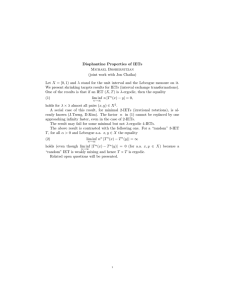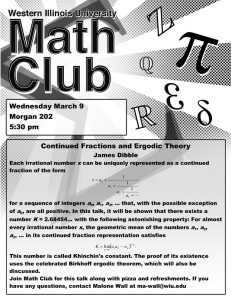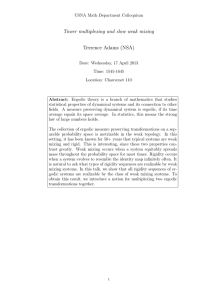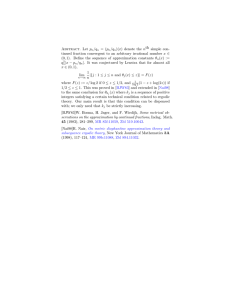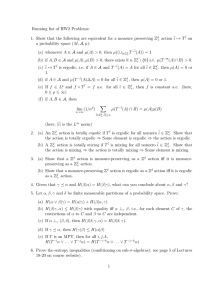A smooth mixing flow on a surface with non-degenerate fixed... (with A. Wright) (submitted)
advertisement
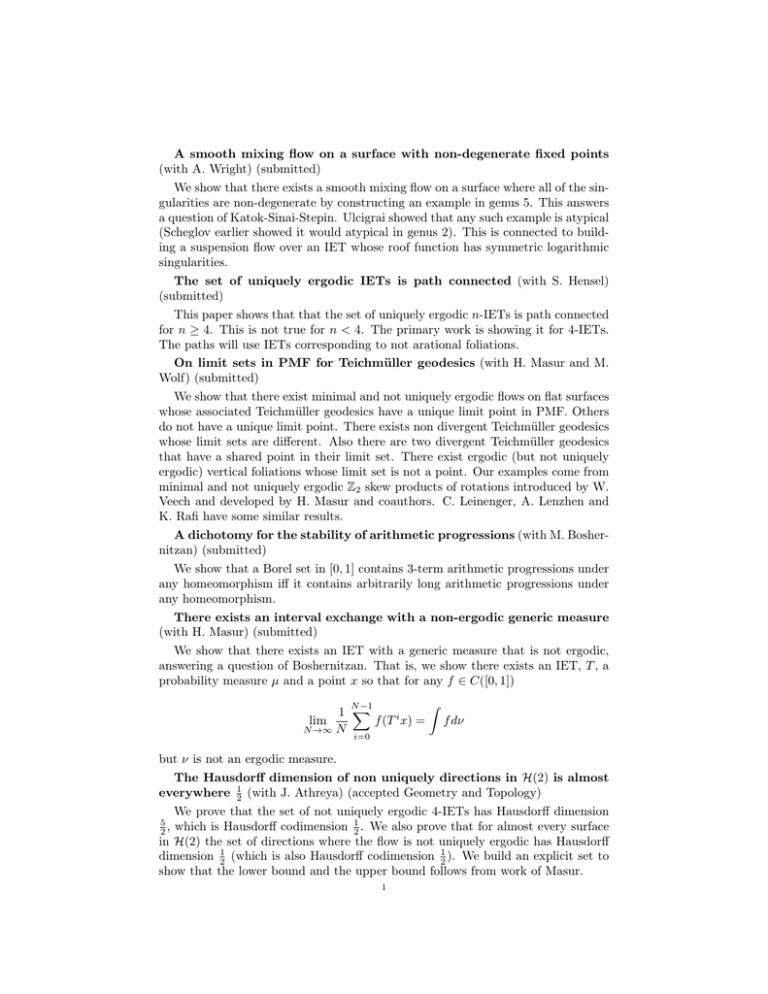
A smooth mixing flow on a surface with non-degenerate fixed points
(with A. Wright) (submitted)
We show that there exists a smooth mixing flow on a surface where all of the singularities are non-degenerate by constructing an example in genus 5. This answers
a question of Katok-Sinai-Stepin. Ulcigrai showed that any such example is atypical
(Scheglov earlier showed it would atypical in genus 2). This is connected to building a suspension flow over an IET whose roof function has symmetric logarithmic
singularities.
The set of uniquely ergodic IETs is path connected (with S. Hensel)
(submitted)
This paper shows that that the set of uniquely ergodic n-IETs is path connected
for n ≥ 4. This is not true for n < 4. The primary work is showing it for 4-IETs.
The paths will use IETs corresponding to not arational foliations.
On limit sets in PMF for Teichmüller geodesics (with H. Masur and M.
Wolf) (submitted)
We show that there exist minimal and not uniquely ergodic flows on flat surfaces
whose associated Teichmüller geodesics have a unique limit point in PMF. Others
do not have a unique limit point. There exists non divergent Teichmüller geodesics
whose limit sets are different. Also there are two divergent Teichmüller geodesics
that have a shared point in their limit set. There exist ergodic (but not uniquely
ergodic) vertical foliations whose limit set is not a point. Our examples come from
minimal and not uniquely ergodic Z2 skew products of rotations introduced by W.
Veech and developed by H. Masur and coauthors. C. Leinenger, A. Lenzhen and
K. Rafi have some similar results.
A dichotomy for the stability of arithmetic progressions (with M. Boshernitzan) (submitted)
We show that a Borel set in [0, 1] contains 3-term arithmetic progressions under
any homeomorphism iff it contains arbitrarily long arithmetic progressions under
any homeomorphism.
There exists an interval exchange with a non-ergodic generic measure
(with H. Masur) (submitted)
We show that there exists an IET with a generic measure that is not ergodic,
answering a question of Boshernitzan. That is, we show there exists an IET, T , a
probability measure µ and a point x so that for any f ∈ C([0, 1])
Z
N −1
1 X
f (T i x) = f dν
N →∞ N
i=0
lim
but ν is not an ergodic measure.
The Hausdorff dimension of non uniquely directions in H(2) is almost
everywhere 21 (with J. Athreya) (accepted Geometry and Topology)
We prove that the set of not uniquely ergodic 4-IETs has Hausdorff dimension
5
1
,
2 which is Hausdorff codimension 2 . We also prove that for almost every surface
in H(2) the set of directions where the flow is not uniquely ergodic has Hausdorff
dimension 12 (which is also Hausdorff codimension 12 ). We build an explicit set to
show that the lower bound and the upper bound follows from work of Masur.
1
2
Every flat surface is Birkhoff and Osceledets generic in almost every
direction (with A. Eskin) (accepted Journal of Modern Dynamics)
In this paper we show that for any flat surface ω, for almost every θ under geodesic flow rθ ω equidistributes with respect to the unique measure supported on
the closure of SL2 (R)ω that is not supported on a lower dimensional submanifold. Moreover, we show that the Kontsevich-Zorich cocycle has the appropriate
Lyapanov spectrum for a full measure set of directions. This strengthens several
known results to hold on every flat surface instead of just a full measure set of
flat surfaces. The key techniques come from homogeneous dynamics and recent
breakthroughs of Eskin, Mirzakhani and Mohammadi.
Every transformation is disjoint from almost every IET (Annals of Mathematics)
In this paper we show that given any transformation of Lebesgue space, almost
every IET is different from it. As a corollary we show that the product of almost
every pair of IETs is uniquely ergodic and so every point is recurrent. A key step in
the proof is that any sequence of density 1 contains a rigidity sequence for almost
every IET, strengthening a result of Veech.
Appendix C of Right-angled billiards and volumes of moduli spaces of quadratic
differentials on CP 1 by J. Athreya, A. Eskin and A. Zorich
This appendix shows that for almost every point in an unstable manifold for
the geodesic flow on the space of quadratic differentials the circle through that
point equidistributes under geodesic flow. This enables a couple of the theorems
of the paper to be asymptotics rather than weak asymptotics. The argument uses
Avila-Resende’s result that there is a spectral gap for SL2 (R) acting on the space
of quadratic differentials and Margulis’ argument for using exponential mixing to
prove the equidistribution of typical circles.
Diophantine properties of IETs and general systems: Quantitative
proximality and connectivity (with M. Boshernitzan) (Invetiones Mathematicae)
This paper shows a variety results on IETs, systems of linear block growth and
general systems. It shows that there are no topologically mixing 3-IETs. It shows
that if µ is an ergodic measure for an IET T then T i (x) ∈ B(y, i ) for any > 0
and µ × µ a.e. (x, y). This result is proper. It also proves the following ergodic
theorem: Let f : X → [0, ∞] be µ-measurable and T : X → X be µ ergodic. if
{si } ⊂ R+ is non-decreasing and there exists c > 1 such that ss2n
> c for all large
n
enough n then lim inf sn f (T n x) is ∈ {0, ∞} for µ a.e. x. In particular it takes
n→∞
finite positive values on a set of measure zero. This shows that for any y we have
that lim inf nd(T n x, y) ∈ {0, ∞} for almost every x. Using the Lebesgue Density
n→∞
Theorem, Cassels showed earlier that for any x this was true for almost every y.
Borel-Cantelli Sequences (with M. Boshernitzan) (Journal d’Analyse Mathematique)
We classify the sequences of points {xi }∞
i=1 ⊂ [0, 1] such
P∞that for any monotone decreasing sequence of positive reals {ri }∞
i=1 with
i=1 ri = ∞ one has
∞
∞
λ( ∩ ∪ B(xi , ri )) = 1. We extend this result to Ahlfors regular spaces.
n=1 i=n
Shrinking targets for IETs (Geometric and Functional Analysis)
3
In this paper we consider the following problem: Given a point p ∈ [0, 1) and a
monotone decreasing sequence of positive reals {ri }∞
i=1 , for typical x ∈ [0, 1) and
IET T will T i x ∈ B(y, ri ) infinitely often? The Borel-Cantelli Theorem
P∞says no if
the sum of the radii converge. We show that for almost every IET if i=1 ri = ∞
then T i x ∈ B(y, ri ) for infinitely many i. The full measure set of IETs depends on
the sequence. P
For almost every IET there exists a monotone decreasing sequence
∞
i
where
{ri }∞
i=1
i=1 ri = ∞ and yet for almost every x we have T x ∈ B(y, ri ) for
only finitely many i. However, if we restrict our sequences of radii by requiring that
iri is monotone decreasing then one full measure set of IETs has that T i x ∈ B(y, ri )
infinitely often for all such {ri }∞
i=1 . Other related results are considered. The
next paper, joint work with D. Constantine, improves this result to consider the
frequency of hits to the shrinking balls.
Quantitative shrinking targets for rotations, IETs and billiards in rational polygons (with D. Constantine)
We consider how often the orbit of a point under an IET visits a shrinking ball
about a fixed point. We show that under some assumptions it is roughly as often
as one would expect.
Theorem 1. For
almost every IET T and any {ri }∞
i=1 such that {iri } is monotone
P∞
decreasing and i=1 ri = ∞ we have
PN
i
i=1 χB(p,ai ) (T x) a.e.x
→ 1.
lim
PN
N →∞
i=1 2ai
We prove a variety of variants of this theorem, in particular establishing an
analogous result for any fixed rational billiard. The proof follows the outline of the
strong law of large numbers. A key step is establishing a quantitative version of
Boshernitzan/Masur’s criterion for unique ergodicity.
There exists a topologically mixing IET (Ergodic Theory and Dynamical
Systems)
This paper shows that there exists an IET with the property that for any > 0
there exists N ∈ N such that n > N implies that for any x we have T n B(x, ) is dense. The next paper improves on this result. In joint work with M. Boshernitzan
(Diophantine properties...) we showed it is false when n = 3.
Topological mixing for residual sets of IETs (with J. Fickenscher) (Communications in Mathematical Physics)
This paper shows that a residual set of IETs with a permutation in a nondegenerate Rauzy class on 4 or more intervals are topologically mixing. This implies
that there are topologically mixing uniquely ergodic IETs. It then proves that
some billiards in L-shaped polygons are topologically mixing. It uses combinatorial
methods to prove the result in the Rauzy class of (4321). It then uses the structure
of Rauzy classes to extend it to the general situation.
Winning games for bounded geodesics in moduli spaces of quadratic
differentials (with Y. Cheung and H. Masur) (Journal of Modern Dynamics)
We show that the set of bounded geodesics in Teichmüller space is a strong
winning set for C. McMullen’s variant of Schmidt’s game, answering a question of
McMullen. We show that the set of badly approximable interval exchanges is also
strong winning. Call a direction θ in a Teichmüller disc q bounded if there is a
4
compact set of Teichmüller space Kθ such that gt rθ q ∈ Kθ for all t. We show that
in every Teichmüller disc the set of bounded directions is absolutely winning for
McMulllen’s variant of Schmidt’s game.
Every transformation is disjoint from almost every non-classical exchange (with V. Gadre) (Geometriae Dedicata)
We show that if S is an invertible measure preserving transformation of Lebesgue
space and π is a ‘permutation’ of non-classical exchanges with at least one preserved
band then for almost every L̄ we have S is different from Tπ,L̄ .
The distribution of gaps for saddle connection directions (with J.
Athreya) (Geometric and Functional Analysis)
We show a variety of result on the gaps between saddle connection directions
for flat surfaces. Three highlights are that for almost every surface there exists a
distribution of normalized gaps, this distribution decays quadratically towards 0 at
0 and a surface has no ‘small gaps’ iff it is a lattice surface. A corollary of a result
in the paper is that the Siegel-Veech transform sends some compactly supported
L∞ functions to functions that are not in L2 .
The Gap Distribution for Saddle Connection Directions
on the Golden L (with J. Athreya and S. Leliévre) (Contemporary Mathematics)
We compute the asymptotic distribution of normalized saddle connection gaps
for the golden L. This is the first example of such a computation for a flat surface
that is not a torus cover.
Skew products over rotations with exotic properties (Geometriae Dedicata)
Answering questions of W. Veech and M. Boshernitzan we show that there exists a Z2 skew product of a badly approximable rotation that is minimal but not
uniquely ergodic. We apply this to show that there is a Z skew product of a badly
approximable rotation where the orbit of Lebesgue almost every point is dense but
Lebesgue measure is not ergodic.
Omega recurrence in cocycles (with D. Ralston) (Ergodic Theory and Dynamical Systems)
Consider the skew product R̂α : [0, 1) × Z → [0, 1) × Z by
R̂α (x, i) = x + α − bx + αc, i + χ[0, 21 ) (x) − χ[ 12 ,1) (x) .
i
We show that for almost every α, x we have that R̂α
(x, 0) ∈ [0, 1) × {0} fairly often.
i
We show that for some α and any x we have that R̂α
(x, 0) ∈ [0, 1) × {0} holds
rarely.
Schrödinger operators defined by interval exchange transformations
(with D. Damanik and H. Krüger) (Journal of Modern Dynamics)
Consider the dynamically defined Shrödinger operator Hx : l2 (Z) → l2 (Z) by
Hx (ū)[n] = u(n + 1) + u(n − 1) + f (T n x)u(n) where T is an IET, f is continuous
and x ∈ [0, 1). We show a variety results on the spectrum of this self-adjoint
operator. In particular, we use Kotani theory to show the absence of absolutely
continuous spectrum in a variety of cases.
Hausdorff dimension for ergodic measures of interval exchange transformations (Journal of Modern Dynamics)
5
Building on an example of M. Keane this paper shows that minimal but not
uniquely ergodic can have a singular ergodic measure that is carried by a Borel set
of Hasudorff dimension 0. The next paper improves this.
On the Hausdorff dimensions of a singular ergodic measure for some
minimal interval exchange transformations
This paper proves a variety of sharper versions of theorems in the previous paper.
Additionally, in the appendix it provides the construction of an IET with a weird
diophantine property: There exists a minimal and not uniquely ergodic IET T with
ergodic measures µ and ν such that
− log d(T n x, y)
= 1 for µ × ν a.e. (x, y)
lim sup
log n
n→∞
but
− log d(T n x, y)
1
lim sup
≤
for ν × µ a.e. (x, y).
log
n
2
n→∞
Homogeneous approximation for flows on translation surfaces
Motivated by a result of L. Marchese this paper shows that for any translation
surface, {ai } non-increasing with divergent sum we have that |Fθt x − x| < ai infinitely often for almost every x and θ. This result is not implied by Marchese’s
result because it applies to sequences that are just non-increasing (rather than iai
being non-increasing) and it holds on every flat surface. It does not imply Marchese’s result because it does not address the difference between arbitrary pairs of
discontinuities.
Ergodic homogeneous multidimensional continued fraction algorithms
(with A. Nogueira)
We provide an alternate proof of Veech’s result that (non-renormalized) Rauzy
induction is ergodic. We extend this to show that the d-dimensional Selmer algorithm is ergodic on its absorbing set.
The densest sequence in the unit circle (with M. Boshernitzan)
We identify the densest sequence on the unit circle. Not surprisingly it is the
most separated one as well.
[0,1] is not a Minimality Detector for [0, 1]2
This paper shows that there exists a non-minimal sequence in S 1 , (x1 , x2 , ..., ),
such that for any continuous function f : S 1 → [0, 1] we have (f (x1 ), f (x2 ), ...) is
minimal.
Arithmetic progressions in regular cantor sets
We show that the middle N1 Cantor set contains arithmetic progressions of length
N
50 log N . A draft is available upon request.
